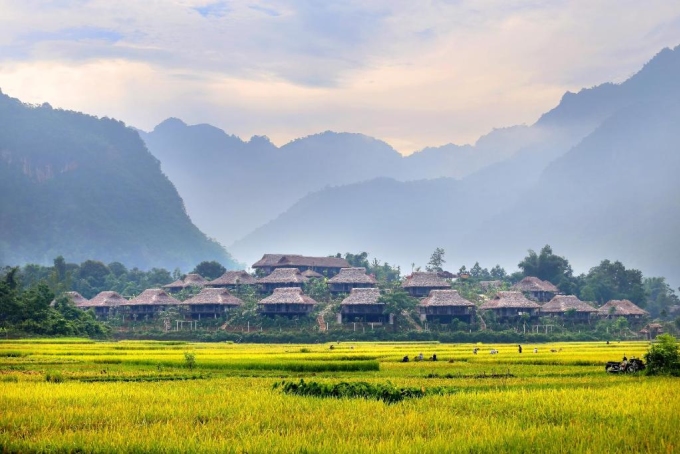
The northern mountainous province of Hoa Binh has been listed among the 71 most beautiful places to visit worldwide by the prestigious US travel magazine Condé Nast Traveller.
Recognised
for its stunning landscapes and rich cultural experiences, the locality is the
only Vietnamese destination to make the list. The magazine’s selection criteria
go beyond impressive natural scenery, incorporating historical value and
visitor experiences.
In
its assessment, Condé Nast Traveller highlighted the local ethnic groups,
including the Hmong, Muong and Dao, as well as endless rice fields as standout
features.

Photo capition: Golden rice fields in
Mai Chau district, Hoa Binh. (Photo: Mai Chau Ecolodge)
As the gateway to Vietnam’s northwestern region, Hoa Binh is known
for its breathtaking scenery and vibrant ethnic cultural identity. In Mai Chau
district, the Lac village is celebrated for its pristine beauty, with rice
paddies surrounded by lush green mountains. From September to late October,
when the rice fields turn golden, the village becomes an ideal spot for cycling
and sightseeing. Lac is also famous for its centuries-old stilt houses, some
nearly 700 years old, shrouded in mist at the foot of verdant hills. Visitors
can engage in traditional Thai ethnic activities, such as weaving handicrafts,
kite flying, folk dancing, bamboo pole jumping, and nightly campfires.
Local cuisine is another highlight, offering mountain specialties
like grilled chicken and fish, com lam (bamboo-tube rice), sticky rice, and
wild vegetables, served at local restaurants or eco-resorts.
Other Asian destinations recognised by Condé Nast Traveller
include Raja Ampat and Bali in Indonesia, the Zhangye National Geopark in
China, Bayon Temple in Cambodia, Jodhpur in India, and the Philippines. Japan
stands out with three entries, namely Mount Fuji, Kyoto, and the Arashiyama
bamboo forest.
Boasting diverse terrain, a mild climate, and rich natural resources, Cao Phong district is increasingly asserting its place on Vietnam’s tourism map, attracting both domestic and foreign visitors. The district is renowned for its stunning landscapes, majestic mountains, a crystal-clear hydropower lake, and the unique cultural identity of local ethnic groups.
With its pristine landscapes, unique cultural heritage of Muong ethnic minority, and an expanding range of visitor experiences, Tan Lac district of Hoa Binh has fast become a captivating destination for both domestic and international tourists.
Until now, Sung village in Cao Son commune, Da Bac district remains the only Dao ethnic community in Hoa Binh province to develop a community-based tourism model. Beyond its untouched natural landscapes, cultural identity serves as the cornerstone attraction for visitors.
Alongside the diverse cultural identities of the Kinh, Muong, Tay, Thai, Dao, and Mong ethnic people, Hoa Binh province is also renowned as the "capital" of the northwestern Vietnamese cuisine, offering unique and distinctive dishes. At festivals, during Lunar New Year (Tet), or on significant family or community occasions, special dishes are prepared, leaving a lasting impression on visitors.
A Phong Linh (Yellow Tabebuia) flower garden in Thang village, Thach Yen commune, Cao Phong district is currently in full bloom, drawing a large number of visitors.
Community-based tourism has been thriving in Pa Co commune, Mai Chau district thanks to advantages in natural landscape and cultural identity.



